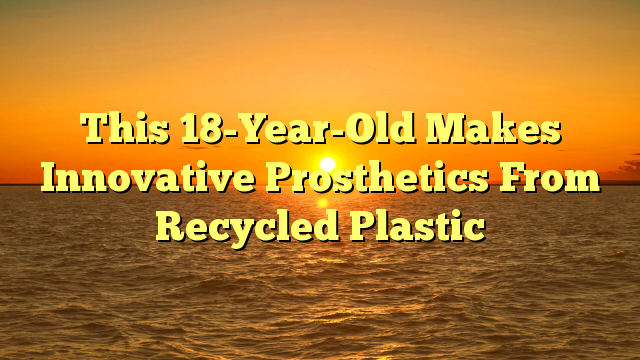
This 18-Year-Old Makes Innovative Prosthetics From Recycled Plastic
http://ift.tt/2i8oyJX
Aaron Westbrook was born with only one hand. Several years ago, while a freshman at New Albany High School in Ohio, he tried out his first prosthetic. It didn’t fit well, and cost about $40,000, a somewhat staggering sum, considering he would eventually outgrow it. “That’s when I realized that there was a really big issue with prosthetics right now,” he says. “They’re too expensive and they’re just plain inefficient.”
So Westbrook, who is now 18, decided to make his own, using the 3D printer in his school’s fab lab. The plastic hand had an elbow-controlled cable system, allowing its fingers open or close. Generally speaking, though, prosthetics like that are task-specific; if you need a special grip, you might need to design a different kind of limb attachment. That can mean a lot of different prosthetics, and a lot of expensive purchases.
“The biggest issue with prosthetics is that they’re just not accessible, they’re just not practical, and they don’t make sense.” [Photo: courtesy Form5 Prosthetics]To make that process more affordable for everyone, Westbrook launched Form5, a nonprofit that customizes mostly open-sourced artificial limb designs in an eco-friendly way. Westbrook collects his own recyclable material, and, eventually, hopes to repurpose outdated hands into other devices, which would close the loop on any waste. “I kind of joke [that] Form5 is a one-man, one-hand show,” he says.
To be clear, Westbrook is just one maker in a decentralized movement, which is making cheaper and more widely affordable products available to lots of people. Many initial designs come from e-NABLE, an open-source community that shares templates with other makers. These don’t replicate top-of-the-line $40,000 myoelectric appendages, but more simplistic muscle-actuated ones, which generally retail for between $6,000 and $10,000. With a 3D printer, that costs can drop to around $35 in raw materials, plus the cost of the machine, which can be up to a few thousand dollars, according to e-NABLE’s analysis.
Of course, results hinge on the DIY manufacturer’s attention to detail and mechanical know-how. All told, the e-NABLE community, which partners with DIY hobbyists around the world, estimates to have aided at least 1,800 people.
Form5 is still a pretty small operation. The organization (so far, the total staff is just Westbrook), officially received nonprofit status this fall. Over the last couple years, what you could call its pilot stage, Westbrook has made several more prototypes to test out, and two appendages for clients with their own specific needs. For one project, Westbrook designed a limb attachment that could hold a cello bow for an elementary school kid named Tate, who wanted to join the orchestra. For another, he did a white-and-black “panda-theme” arm for a 7-year old named Maddie, complete with several geometric cuts to create an inlayed bear face.
Many initial designs come from e-NABLE, an open-source community that shares templates with other makers. At the same time, Westbrook’s idea outgrew the fab lab, so he has been financing different gear through Kickstarter, and a loose network of donors and community supporters. To make the recyclable angle a reality, his current setup includes a plastic shredder that turns waste into mulch and pellets, which can then be run through an extruder to create filament, which is spooled for later use on its own machine. Both the extruder and spooler were provided for free from a company called Filabot.
The setup requires PLA or polylactic acid based plastic, which has a lower footprint because it’s initially made from corn starch or sugarcane, not petroleum. It doesn’t emit noxious fumes during manufacturing, which also makes it easier for novices to recycle. PLA is also found in food grade plastics and Westbrook initially sourced 2,000 cups by starting a high school collection program that took in used ice-coffee cups and hot-beverage lids. He painstakingly washed each one.
While his two big client jobs used traditionally bought plastic, because it took awhile to work out the kinks of recycling (some of his plastic mulch wasn’t fine enough, for instance, which caused issues with the extruder), everything is now up and running. “That was the one thing I wasn’t anticipating because I can pretty much do everything with one hand,” he says. “But it’s definitely weird to be running three different machines at once with one hand.”
Westbrook initially sourced 2,000 cups by starting a high school collection program that took in used ice-coffee cups and hot-beverage lids. He painstakingly washed each one. [Photo: courtesy Form5 Prosthetics]Westbrook, who is attending Antioch College in Yellow Springs, Ohio, this fall, should be able to continue his work there. The school has provided lab space and allowed him to design his own major, which he’s calling “eco-friendly digital fabrication.” The idea is to be more STEAM than STEM-focused, he says, meaning that in addition to a classic science, technology, engineering, and math classes, he’ll be learning art and design principles, especially 3D modeling.
He’s taken the plastic he collected while in high school with him, and hopes to start a similar program at the college, although his old school has expressed an interest in continuing, too, he says. That free plastic supply will lower overhead, which should help offset some equipment costs. In addition to the usual tabletop-size printer, Westbrook uses a larger version for bigger work.
While some of the nonprofit’s business model is still coming together, he hopes to create and share some of his own open-source designs within the next year. “The biggest issue with prosthetics is that they’re just not accessible, they’re just not practical, and they don’t make sense,” he says. “To fix those things with recycling and 3D printing and open-source files, I think that’s definitely the direction the industry needs to head.”
business
via Fast Company http://ift.tt/1cEtZb6
